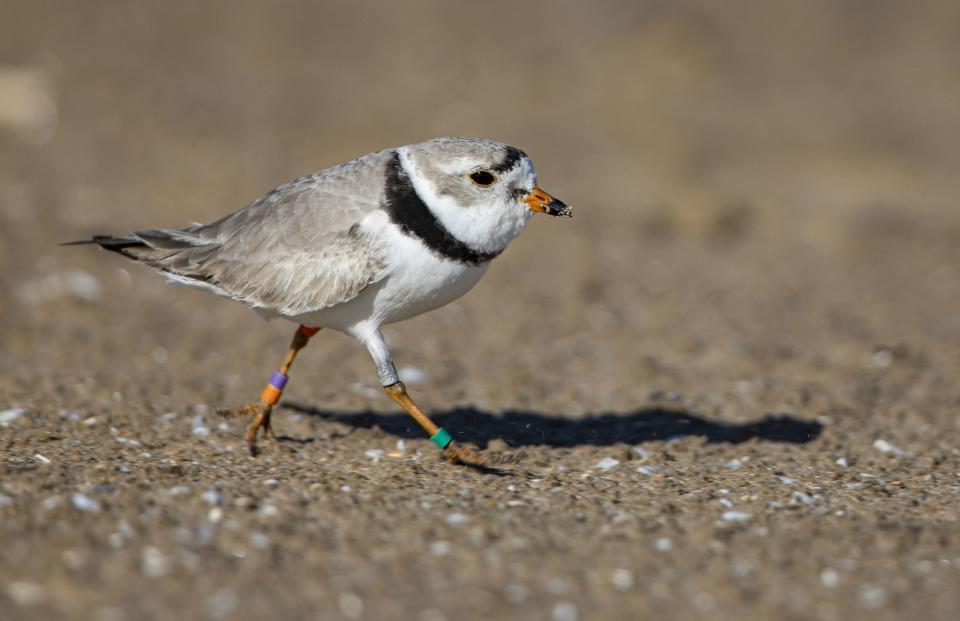Fans celebrate Monty and Rose, the piping plovers who aided conservation and brought Chicagoans together
Birders, biologists, conservationists and those who happened to be swept up in the tale of two little birds gathered this week at Montrose Beach to mark the end of one story — while another was just beginning.
The crowd gathered Wednesday night to celebrate the lives of Monty and Rose, the endangered piping plovers who three summers ago became the first pair to nest successfully in Chicago in decades.
Monty died earlier this month at Montrose Beach while waiting on Rose, who never returned.
On Wednesday, the cast of human characters who have become regulars in the Monty and Rose saga was present: the coordinator known as the mother of the monitoring effort, a birder who loved sharing her binoculars with her Latinx community, a conservationist credited with restoration of the dunes that provided a welcoming home.
“With every wing beat, Monty and Rose and their progeny brought people together,” said Tamima Itani, who has led Chicago’s plover effort.
But there was another return visitor present on the day of the memorial — Imani, one of last summer’s chicks, seen in the sand not far from where his father took his last breaths.
“The end of Monty and Rose’s story here at Montrose is not the end of this series,” said Edward Warden, president of the Chicago Ornithological Society. “It’s just one book.”
Monty and Rose gave fans quite a narrative to follow. The birds were already up against enough when they showed up in Chicago as members of a species once down to about a dozen nesting pairs in the Great Lakes. They then managed to meet a list of ever-refreshed obstacles: the encroachment of a beachside musical festival, high lake levels and severe storms, the death of chicks and hungry skunks.
Through it all, they managed to fledge seven chicks.
“It was really hard for all of us to lose any chick, any egg,” said Louise Clemency, with the U.S. Fish and Wildlife Service. But “if all the Great Lakes piping plover nests had that rate of success, we would be upward toward recovery.”
Warden credited the volunteer and education efforts of many in the crowd with helping create “a brand” for Monty and Rose — the birds have appeared on shirts, beer cans and in two documentary films.
On Wednesday, Monty and Rose appeared on posters, along with their offspring, near the site of Monty’s death in the Montrose plover habitat, as some visitors took selfies with the memorial in between a downpour.
“They left a legacy of unity, love, friendship and conservation that will be long remembered,” Itani said.
But there might be more opportunities ahead to rally behind Montrose plovers.
After appearing earlier this season in Duluth, Imani, who was named for “faith” in Swahili, touched down this week at Montrose. The young bird is banded like his parents were, making him identifiable.
When thinking of Monty and Rose, one word that comes to mind is mystery, said Leslie Borns, the longtime Montrose Beach dunes steward.
“It seems that no matter how much we know and can learn about nature, there’s still so much that remains a mystery to us,” Borns said. “Perhaps one of the greatest mysteries of all that I have seen is the return of Imani.”
As she watched the young bird forage where his father stood days earlier, Borns said she was reminded that life goes on.
“I hope that the sadness is melting away and being replaced by joy and gratitude,” Borns said.
Francie Cuthbert, a leader in the Great Lakes plover recovery effort, said she’s still surprised by the emotion attached to Monty and Rose and the following they’ve acquired.
As for Imani, Cuthbert said, “Isn’t that something?”
“I hate to use the word amazing, but it is amazing,” said Cuthbert, a professor in the Department of Fisheries, Wildlife and Conservation Biology at University of Minnesota. “The plovers know the Great Lakes.”
First-year birds tend to arrive at their nesting locations later than more experienced birds, Cuthbert said, and will sometimes bounce between sites before finding a mate and settling down.
“We haven’t finished the story with Imani,” Cuthbert said. “I just hope that he survives, and he finds a mate.”
The overall plover season looks promising, Cuthbert said, between lower lake levels and a strong finish to the last nesting season. And “every bird counts.”
But few have captured the hearts of as many people as Chicago’s piping plovers.
“Monty and Rose made such a contribution to conservation,” Cuthbert said. “It’s something you couldn’t really predict.”
Now, birders are hopeful about what’s next.





